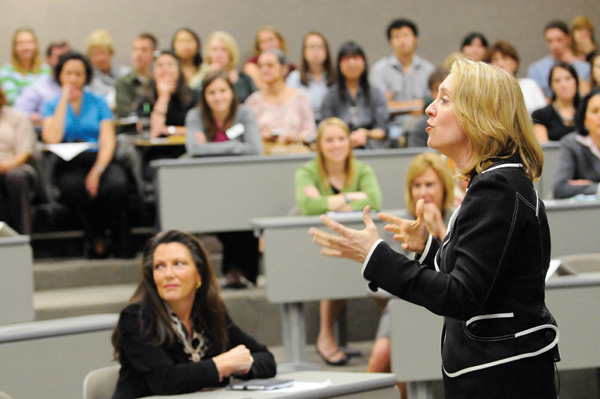
Jennifer Allyn, a managing director at PricewaterhouseCoopers, said women need to be recognized and inspired by supervisors to sustain the effort it takes to achieve partnership.
PricewaterhouseCoopers recruits 50 percent women at the associate level, yet women make up just 17 percent of partners in the firm. That disparity troubles Jennifer Allyn.
“We cannot run our firm without women, but as they advance through the firm, they leave in larger numbers than their male colleagues,” said Allyn, a managing director in the Office of Diversity at PricewaterhouseCoopers. “How do we keep women in the game long enough to rise to the top so we can change those numbers?”
Allyn visited the Freeman School on Oct. 18 to deliver a presentation titled “A Candid Conversation About Women & Ambition.” The lecture was presented by the Louisiana Chapter of the International Women’s Forum and sponsored by the Freeman School, the Newcomb College Institute, the Tulane Chapter of the National Association of Women MBAs and the Tulane Office of Institutional Equity.
Allyn’s role at PwC is to retain and advance female executives, and an essential part of that is encouraging women to be ambitious, a concept many women have a hard time embracing. That need not be the case. Allyn said ambition simply refers to a desire for mastery, and attaining that level of mastery typically takes a long time.
“To master anything—the violin, an athletic sport, anything in your role at work—takes about 10,000 hours, which is why in professional services firms like ours, the path to partnership tends to be about 10 years.”
To sustain the effort required to pursue a goal for that length of time, Allyn said employees need inspiration and recognition, but in order for supervisors to inspire and recognize their employees, they need to understand the differences between men and women when it comes to ambition.
Allyn cited an experiment conducted by researchers at the University of Pittsburgh in which men and women were paid 50 cents for every simple math problem they could solve in a five-minute period. The participants each knew how many problems he or she got right, but they didn’t know how their performance stacked up against other participants. After the first session, the participants were given the option of continuing at the piece rate or entering a tournament in which the participant solving the most problems would receive $2 per correct answer while the others would get nothing.
Although there was no difference between men and women in ability to solve the problems, 73 percent of the men opted to enter the tournament compared to just 35 percent of the women. Those numbers have serious implications when one thinks of partnership as a tournament for professionals.
“High-performing women are not entering the tournament in high enough numbers,” Allyn said. “When I look at that 17 percent partnership number for women, we’re not going to have a breakthrough if women continue to opt out of the tournament.”
So how do you get more women to opt in? Allyn said it’s through a combination of push and pull. Women have to push forward to pursue career goals and demonstrate their commitment, but at the same time managers must pull them forward with recognition and mentorship. And the best source of recognition and mentorship for women is other women.
“The most powerful way for us to get recognition is to create networks where we provide it for each other,” Allyn said. “No matter who you are—male or female—the recognition becomes less as you rise through the ranks. To have that sort of nurturing and support, we’re going to need to create it for each other.”


